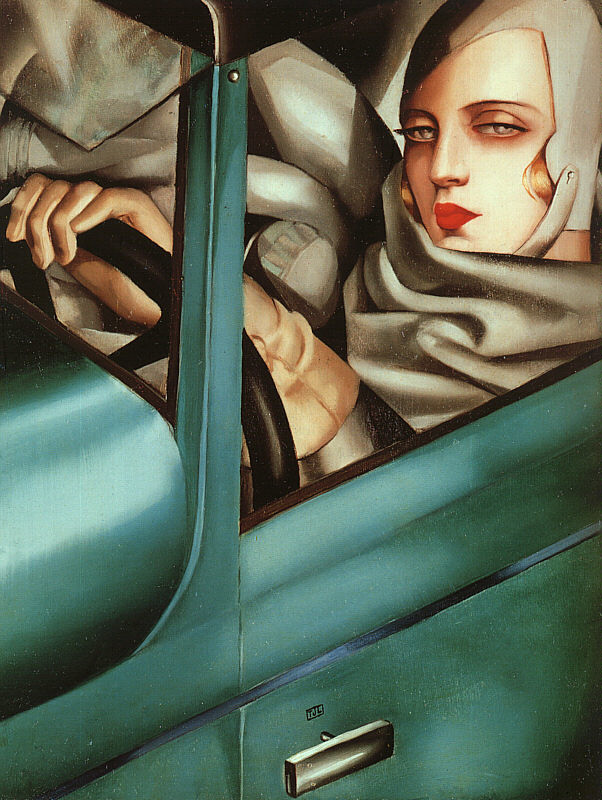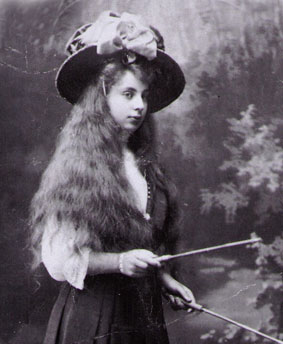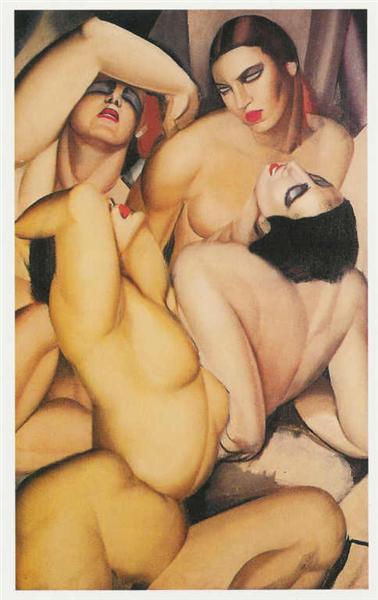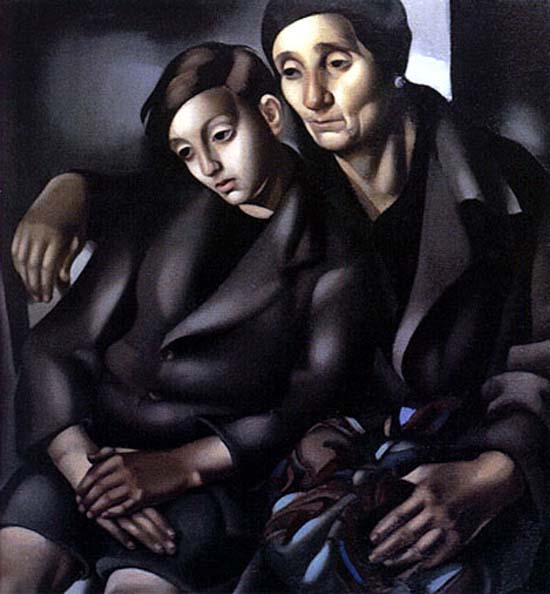Mikhail Mansion—From Military Into Interactive Art
Mikhail Mansion is an artist and engineer who blends digital and mechanical elements to create interactive experiences that foster connections...
Agnieszka Cichocka 8 January 2024
4 March 2024 min Read
You may not know her name but you surely know her works. Tamara de Lempicka (1898-1980) is the icon of a modern woman, the epitome of Art Deco. She created portraits in her unique style by blending Renaissance, Neoclassical, and Cubist influences in her own revolutionary way. We had the opportunity to chat with her great-granddaughter, Marisa de Lempicka, about her great-grandmother’s artistic career, originality, and also why you will never see a bad picture of her.

Marisa de Lempicka, along with her sister, Cristina, and their mother, Victoria (who is the daughter of Lempicka’s only child, Marie Christine, known as Kizette) maintain the artist’s estate. Through the Estate of Tamara de Lempicka, LLC, her family ensures Lempicka’s legacy continues to thrive and grow through myriad avenues, including the media, publications, exhibitions, and appropriately, through fashion.



LK: I was first introduced to Tamara de Lempicka in college and, of course, it was through her very famous Autoportrait. Learning about her in the last few years has been so much fun – she was such an extraordinary woman.
ML: I’m working on two documentaries and one of the producers, a young woman, said “Tamara is the most known unknown artist.” So many people have seen her art, it’s so iconic, very recognizable, especially that from the 1920s and 1930s but so many don’t know her name, her story, who she was. She had such an amazing life. I included a new chapter in Passion by Design, my grandmother’s biography of Tamara, with new pictures but also about her relevance today, how she has been influencing people in fashion, theater, and music. It’s important to know that she wasn’t just this old lady that painted in the 1920s and 1930s, her art and her life are influencing people today.
Lempicka was born Tamara Rozalia Gurwik-Górska into a wealthy family in Poland. As a young girl, she enjoyed drawing, took art lessons, and visited world-class museums with her grandmother.

LK: There’s the story when a young Lempicka saw a portrait that had been done of her and wasn’t too impressed with it, she thought she could do better and set to work drawing her sister’s Adrienne’s portrait. Is this how it all began?
ML: This story very well shows her personality, she was so sure of herself. Her remarkable self-assurance is seen throughout her whole life. It is such a great lesson we can learn from her that if you believe in yourself, you can accomplish anything. She really knew that she could get what she wanted. It was a lot of work, but she was very sure of herself. Going through her archives and papers we discovered that she was an extremely talented artist as a young girl. She had some drawings of landscapes, another work called The Kiss from when she was 10 or 12 years old. It’s amazing. She already had a gift for art.
In 1916, 18-year-old Tamara Górska married Tadeusz Łempicki and moved to Paris. When World War I broke out they did not get out of Petrograd quickly enough and Tadeusz was imprisoned. Łempicka searched for her husband and contacted various foreign consuls for assistance. With the help of the Swedish consul, she was able to free Tadeusz and the young couple reunited in Copenhagen. After the war, they emigrated to Paris and needed money right away. Kizette was born in 1916. Lempicka’s sister, Adrienne, suggested that Tamara might return to art.

LK: How did she decide to turn to art as a career?
ML: Though Tamara was a starving artist at first when she left the Bolsheviks and they [Tamara and Tadeusz] ended up in Paris with her jewels, her clothes, and a little money. But within a year all that was gone. They needed to pay bills. Her sister Adrienne, who was already a successful architect, said to her “remember, Tamara, you were such a talented artist. Why don’t you support yourself as a painter?” So she didn’t do it for a love of art at first, but she needed to survive and support her daughter and husband.
LK: Her style is incredibly unique. Once you see an Art Deco painting by Lempicka, you know who she is. She’s working in Paris and going on around her is Picasso’s Cubism, Surrealism, Dada, but she found what worked for her and stays true to it.
ML: That’s a good thing and a bad thing. That’s part of the reason why she’s not as well known, she doesn’t fit into a box. She’s not Cubist, Surrealist, so where do you put her? She’s been displaced.
LK: When I saw Autoportrait, other than Art Deco broadly, I didn’t know what category she fit into. The sharp angles and lines of Cubism, the influences of Neoclassicism, plus that sensuality. She isn’t easily classified. Her figures, especially her nudes, are so powerful and again, you can’t categorize them. It’s a bold, open sensuality, an unapologetic look. There were very few women doing nudes at this time – Suzanne Valadon, to whom Lempicka is sometimes compared, comes to mind though their styles are very different.
ML: They are nude paintings by a woman but there’s a desire there because she desired women too. Not a demure nude, a raw desire with a female eye and with empowerment. These women are happy with their sexuality. They aren’t hiding.

LK: Even though Lempicka enjoyed her full social life, she also had a business savvy; she wasn’t just this society woman who happened to paint.
ML: She understood that being in society, the way she portrayed herself, her fashion, her scandalous parties, was critical. She was an extremely smart person. She read five newspapers in different languages so she could keep up with the day. She was a shrewd businesswoman and had an instinct for personal branding. Her involvement in society – she enjoyed it – but it was also to build her fame. Of course she liked the attention, but she also made it bigger than what it was because she wanted people to talk about her because that got her more commissions.
LK: Lempicka isn’t this romantic artist, she’s very pragmatic. This disadvantaged her in a way when it came to her relationship with other artists who could reject the wealthy elite, even if they were patrons. When it was more common to scorn the bourgeois and upper classes, she bought into society and was very much a part of it. She courted them, as well as the press.
ML: Tamara did not let people just take snapshots at her parties. She invited the press to her soirees and and unveilings. She would give them photographs of herself by some of the most famous photographers of the day. You’ll never see an ugly picture of Tamara, every single picture is fantastic because that was part of her image and her branding and what she wanted the world to see. It was a very successful strategy. She was building her image as a star.

Lempicka and Tadeusz separated in 1928 and eventually divorced, which devastated Lempicka and she was unable to work for a time. She eventually returned to her art, finding solace in the frenzy of commissions she received.
In 1934, she married Baron Raoul Kuffner, a wealthy man who had been a collector and patron of hers. Having waited too late to leave the dangers of World War I and recognizing similar signs now two decades later, Lempicka and Baron Kuffner, relocated to Hollywood in 1939. The press dubbed her as “the Baroness with a Brush.” A title that was hard to stomach for a person who fought hard to always be recognized as an artist first, before even that of wife and mother. Her wartime situation was very different this time, she was no longer the starving artist trying to get established. Instead, she tried new things.

LK: Why do you think she decided to stylistically branch out the way she did?
ML: There were different reasons, I think. Her second husband was wealthier than she was and so the hunger was not there as it was before. She says too, that knowing what was happening in Europe during the World War II, she was heartbroken, she was sad. Imagine her friends and family, especially in Poland, that was her homeland and there was so much persecution. She was already devastated by the Spanish Revolution and persecution of all the artists. She painted The Refugees in 1937. The same time she did these amazing portraits of people torn by war. She was very heartbroken, her friends and family, the second time in her life, she built a beautiful life for herself in Paris, and then it was all gone again. So I think she felt she can no longer paint those portraits, she had to paint something deeper.

ML: The still lifes, the country scenes, they’re very simple – she just needed to connect to the more simple things in life. She didn’t need to paint for money anymore, but she needed to paint because she was an artist and needed to keep expressing herself, which she did in many different ways. She did that and then Surrealism, the Abstracts, and the palette knives. She was very inspired by Pompeii and seeing the frescos. If you look at those palette knives, they look like those frescoes. In Pompeii, those earthy colors. She was moved to tears by the people of Pompeii, how they, like her, from one day to the next, one moment to the next, your life is completely changed.
LK: I think that’s going to surprise a lot of people that there’s more to her than just Art Deco.
ML: That’s why I like to talk to different people about her because I think it’s important to know that she was a complete artist, a true artist. The Art Deco, yes, that’s the best known, but she was experimenting. She tried many different things like many artists and she should be recognized for everything. Her talent is there, it’s in the details. There are paintings that she puts a scroll at the bottom that she signs, things like that that are so creative.
LK: That reminds me of Dutch still lifes.
ML: Yes, she was inspired by those!

LK: Unfortunately that work isn’t as well known. In her daughter Kizette’s book, Passion by Design, she draws parallels to Lempicka’s contemporaries Mary Pickford and Gloria Swanson. They’re known for this “one thing” – for Pickford, it was as the eternal “girls with curls” and for Swanson, it was as a silent film siren. When they try something new, people don’t want it and reject them. Pickford cut her hair and acted in roles that were age appropriate and Swanson tried to transition to films with sound. Lempicka tried to branch out from the Art Deco paintings and try a different style.
ML: That was heartbreaking for her. She was so successful and then she moved to the United States, and she wasn’t as successful or as well received. She was getting older too. Abstract expressionism was starting to get en vogue and she just didn’t get it. For her, art had to be beautiful and reflect beauty.
LK: Similarly, along the line of art having to be beautiful, Lempicka once said: “Even when I was a school girl in Switzerland, I didn’t like the paintings of the Impressionists. Cezanne would draw a few apples, but the apples were badly drawn. And the colors – why is it all so dirty? I said to myself: They are dirty. It’s not precise. Mind the precision. A painting has to be neat and clean.”
ML: There’s a bit of a mistranslation, not “dirty” but “muddy” painting. Her later palette knives are a little more like that, but in those days, it had to be clear.

LK: Her colors are so strong and vibrant, particularly those of the Art Deco era, which reminds me of Titian’s bold, crisp colors.
ML: Her colors were made with mineral pigments, malachite and lapis lazuli. When she moved to the States, they were too expensive to make. They use synthetic and she could not get those colors she loved so much. Kizette’s husband was a geologist so he helped her get stones and she was able to get her colors again.
LK: Looking back on her life and how she did what she wanted without giving much thought to social mores, it would be easy to call her a feminist but we don’t want to prescribe labels to people, especially those that have passed away. It was her lifestyle and choices that were very much ahead of her time, she had freedom that was unique, something that appeals to the 21st century women.
ML: I just learned an interesting detail when I was in Paris – I had visited Tamara’s atelier before, but I just learned that at 29 years old she owned not just the atelier but the entire building. It was one of the most modern buildings in Paris. Only at 29! Tamara was a bit of narcissist. She never really thought that she was trying to empower women, if women admired that then great but she did it for herself, because that’s the way she wanted to live. She had affairs with women because she was experimenting and loved beauty and thought she could do whatever she wanted. Remember the generation before, the women were wearing corsets, couldn’t have their own bank accounts, if they wanted to go out to park, they needed a chaperone, couldn’t go out on her own. This is a new thing, new liberation, they have their own bank accounts, they can make money, they can cut their hair, they wore the scandalous red nail polish and red lipstick. Short hair, short skirts and they could actually breathe. For the first time they drove cars, played tennis, golf and skied. You have to put her life in the context of the times, she was a woman of her day, for sure, taking advantage of these new liberties and advantages women had. We see her as an inspiring figure because she took advantage of everything she could get and ran with it.
LK: This is something everyone would like to aspire to, to live life and hopefully have fun doing it. She had her mantra, “no miracles only what you do.”
ML: Yes, work hard for what you want.
LK: And you make your way in the world as she did. She didn’t have a male figure to assist her, she wasn’t part of an artistic group or movement. She did it on her own. I think in some ways, that benefits her. If you think about the women that are associated with men, the women are overshadowed by them. Like Francoise Gilot, she’s always mentioned as Picasso’s partner or muse. Few say she’s an artist too. She was a wonderful artist in her own right. Marie Laurencin, with Apollonaire. Suzanne Valadon, whom Lempicka is compared to, is overshadowed by her son, Maurice Utrillo. Gwen John with both her brother Augustus John and also with Rodin.
ML: Valadon paints women like Tamara does. Very raw. But Tamara didn’t want those associations. She didn’t have a lot of art dealers, she had galleries she worked with, but she represented herself. She didn’t want anyone to represent her. She would go herself, show and sell her art. She was such a creative but also a good business person. It was tough, especially being a woman, but she did it. She was determined.

Many thanks to Marisa de Lempicka for taking the time to speak with us.
You can check the official website of the Tamara de Lempicka Estate established by Victoria de Lempicka, granddaughter of artist Tamara de Lempicka, and mother of Marisa de Lempicka.
DailyArt Magazine needs your support. Every contribution, however big or small, is very valuable for our future. Thanks to it, we will be able to sustain and grow the Magazine. Thank you for your help!